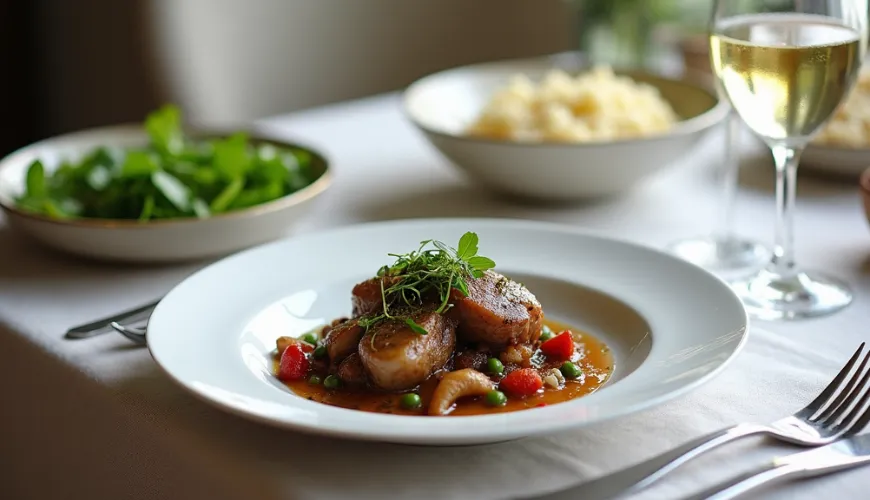
Discover the Secrets to Easily Preparing the Perfect Ossobuco Recipe

Ossobuco - An Italian Classic That Has Captured the Hearts of Czech Chefs
When you mention "ossobuco," many people envision the aroma of a hearty broth, tender meat that falls apart under the fork, and a rich sauce you'll want to soak up to the last drop. This traditional Italian specialty originates from Lombardy, specifically from the Milan area, and it literally means "bone with a hole" – a slice of meat with a bone, inside which is a buttery soft marrow. The marrow is considered a delicacy that ossobuco connoisseurs look forward to the most.
In recent years, ossobuco has experienced a renaissance in Czech households. Thanks to the popularity of cooking shows like Ano, šéfe! or Šéf na grilu, the ossobuco recipe by Zdeněk Pohlreich has become a sought-after gastronomic experience. Whether you opt for the traditional veal ossobuco or choose a more accessible option like beef ossobuco, the result will reward you with the full taste and aroma of Italy.
What Exactly is Ossobuco and Why Does It Deserve Your Attention?
Ossobuco is typically prepared from a veal shank cut into thick slices with the bone. The bone marrow, which releases into the sauce during long braising, gives this dish its characteristic flavor and silky texture. Veal is tender and has a delicate taste, but in Czech conditions, it can be challenging to find and more expensive. Therefore, many chefs opt for beef ossobuco, which, if well-prepared, offers an equally profound gourmet experience.
Alternatively, there is beef ossobuco steak, which is prepared more quickly than the traditional recipe, often on the grill or pan. This method is ideal for those who love the intense flavor of beef but don't want to wait several hours for the result.
And why does ossobuco deserve a place of honor in your kitchen? Because it is a dish that combines the best of meat, bone marrow, broth, vegetables, and aromatic herbs. Moreover, it can be very sustainable – using parts of the meat that would often go overlooked. In Italian cuisine, there are no "second-rate" parts of the animal, only those that need more time and love.
The Original Ossobuco Recipe and How to Prepare It at Home
Although there are various versions, the base remains the same: slices of meat with the bone are first seared in a pan, then braised with root vegetables, tomatoes, white wine, and broth. A classic component of Milanese ossobuco is gremolata – a mixture of chopped parsley, lemon zest, and garlic, which is added at the end and gives the dish freshness.
Ingredients (for 4 servings):
- 4 slices of beef or veal ossobuco (about 3–4 cm thick)
- 1 large onion
- 2 carrots
- 2 stalks of celery
- 3 cloves of garlic
- 200 ml dry white wine
- 400 g tomatoes (fresh or canned diced)
- 500 ml beef or vegetable broth
- 2 tablespoons olive oil
- Salt, pepper
- Fresh thyme or rosemary
- Lemon zest, parsley, and garlic for gremolata
Method is simple but requires time: season the meat with salt and pepper, and sear it in oil until golden brown. Remove it and sauté the onion, carrots, and celery cut into small cubes in the drippings. Add garlic, wine, tomatoes, and broth, return the meat to the pot, and braise under a lid at a low temperature for at least two hours. Finally, add gremolata and serve with risotto, mashed potatoes, or just a piece of fresh bread.
For those seeking inspiration from a professional, there is also the ossobuco recipe according to Pohlreich, which adheres to authenticity while adding a chef's precision. Pohlreich recommends dusting the meat with flour before searing, which helps create a smooth sauce with an ideal texture. He also emphasizes the importance of high-quality broth and patience – "luck favors the prepared, but flavor favors those who do not rush."
How to Choose the Right Meat?
True ossobuco milanese is made from veal, but in Czech conditions, beef is more commonly used. Both options have their advantages – veal ossobuco is more tender, cooks faster, and has soft bone marrow. Beef ossobuco recipe offers a more robust flavor and a lower price, and if you choose quality meat, the result will be just as good.
In specialized butcher shops or at farmers' markets, you might also find ossobuco steak, slices of shank meat prepared like traditional steaks. This method is less traditional but offers quicker preparation, for instance, when cooking on the grill.
One Czech chef who regularly prepares ossobuco described his experience like this: "When I first tasted ossobuco on vacation in Italy, I thought I couldn't make anything similar at home. But then I tried – and found that all you need is good meat, time, and a quality base. Today, it's one of our favorite dishes."
Why Does Ossobuco Fit Into Modern Sustainable Cooking?
In an era where more people are considering the origin of their food and the effort to utilize the whole animal, ossobuco becomes an ideal example of the nose-to-tail cooking concept. That is, a concept where waste is minimized, and even less common parts of the meat are used. The shank, crucial for ossobuco, would often otherwise be used for broth. Thanks to this recipe, it earns its rightful place on the plate as the evening's star.
Moreover, ossobuco perfectly fits the slow food concept – slow cooking with an emphasis on quality ingredients, local sources, and traditional methods. Although its preparation takes several hours, it mostly requires no intervention from the cook. Just let it slowly simmer in the oven or on the stove.
This makes it ideal for a weekend lunch or festive dinner. It pairs wonderfully with naturally fermented wines, homemade pasta, or risotto alla milanese.
Tips for Perfect Ossobuco
- Don't be afraid to experiment. Instead of tomatoes, you can try a version without them – the so-called "bianco" version with white wine, broth, and lemon.
- Use a cast-iron pot. It enables even cooking and maintains temperature throughout the braising.
- Don't lose the marrow. During cooking, the marrow might fall out – try keeping the meat in the pot bone side up, or cover the opening with a piece of foil.
- Prepare gremolata right before serving. This way, it retains its freshness, and the aroma beautifully wafts over the hot meat.
The magic of ossobuco lies in its simplicity, honesty, and respect for the ingredients. From ordinary ingredients, a dish emerges that can impress even the most demanding guests. Whether you opt for beef ossobuco, classic veal, or a modern grilled version, one thing is sure – once you taste it, you'll gladly return to it.

